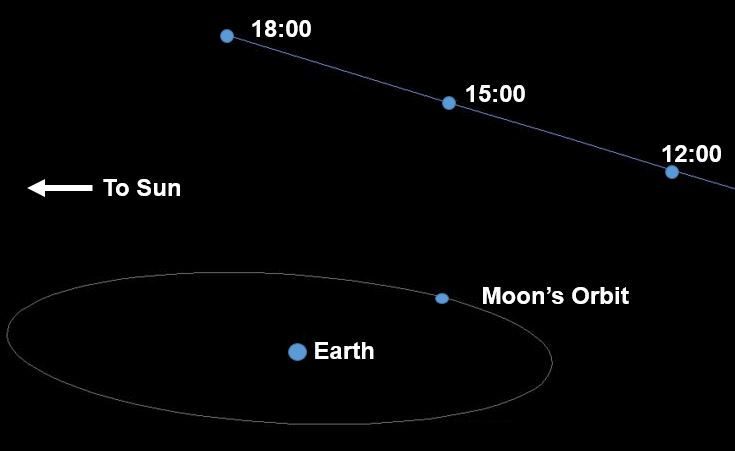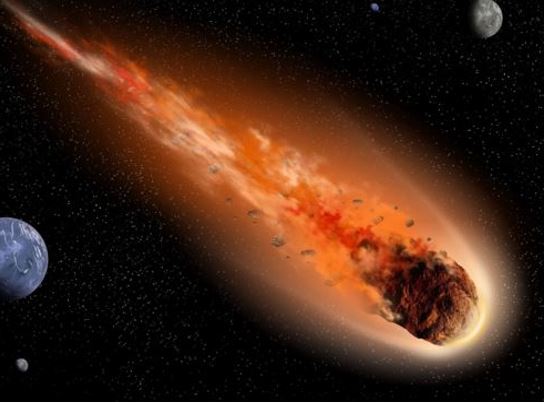An asteroid dubbed The Great Pumpkin will whizz past super-close to Earth by cosmic measures during the Halloween period. Technically called 2015 TB145, it was only detected three weeks ago by researchers at the University of Hawaii’s Pan-STARRS-1 (Panoramic Survey Telescope and Rapid Response System) on Haleakala, Maui, part of the Near-Earth Object Observation (NEOO) Program.
It is expected to pass near Earth on October 31st, 2015, at 10:01 a.m. PDT (1:01 p.m. EDT).
The Great Pumpkin, a 400-meter-wide rocky body that orbits the Sun, is travelling at 35 kilometers (21.7 miles) per second. It will come within approximately 460,000 kilometers (298,000 miles) of Earth, which is a bit further away than the Moon (384,400 kilometers or 238,855 miles).
 A graphic depicting the orbit of The Great Pumpkin. The asteroid will safely fly past Earth slightly farther out than the moon’s orbit on Oct. 31 at 10:05 a.m. Pacific (1:05 p.m. EDT and 17:05 UTC). (Image: Jet Propulsion Laboratory. Credit: NASA/JPL-Caltech)
A graphic depicting the orbit of The Great Pumpkin. The asteroid will safely fly past Earth slightly farther out than the moon’s orbit on Oct. 31 at 10:05 a.m. Pacific (1:05 p.m. EDT and 17:05 UTC). (Image: Jet Propulsion Laboratory. Credit: NASA/JPL-Caltech)
Great opportunity to study an asteroid
The relatively large asteroid’s trajectory will be slightly outside one lunar orbit, giving scientists a fantastic opportunity to collect data about a passing space rock.
NASA scientists are tracking the asteroid with several optical observatories and radar capabilities of its Deep Space Network at Goldstone, California.
Paul Chodas, manager of the Center for Near Earth Object Studies at NASA’s Jet Propulsion Laboratory (JPL), said:
“The trajectory of 2015 TB145 is well understood. At the point of closest approach, it will be no closer than about 300,000 miles – 480,000 kilometers or 1.3 lunar distances. Even though that is relatively close by celestial standards, it is expected to be fairly faint, so night-sky Earth observers would need at least a small telescope to view it.”
The asteroid is too small to have any detectable gravitational effect on anything here on Earth or the Moon, including our tectonic plates or tides.
 An asteroid is a small, rocky body that orbits the sun. Many asteroids are found between the orbits of Jupiter and Mars.
An asteroid is a small, rocky body that orbits the sun. Many asteroids are found between the orbits of Jupiter and Mars.
Lance Benner, of JPL, who leads NASA’s asteroid radar research program, said:
“The close approach of 2015 TB145 at about 1.3 times the distance of the moon’s orbit, coupled with its size, suggests it will be one of the best asteroids for radar imaging we’ll see for several years. We plan to test a new capability to obtain radar images with two-meter resolution for the first time and hope to see unprecedented levels of detail.”
While tracking the rock, researchers will use a 34 meter (110 foot) DSS 13 antenna at Goldstone to bounce radio waves off it. Radio echoes will be collected by the National Astronomy and Ionosphere Center’s Arecibo Observatory, Puerto Rico, and the National Radio Astronomy Observatory’s Green Bank Telescope in Green Bank, West Virginia.
NASA’s research team hopes to obtain radar images of the Great Pumpkin as fine as approximately 7 feet (2 meters) per pixel, which they hope will reveal a wealth of detail about its shape, dimensions, surface features, and other physical properties.
Benner said:
“The asteroid’s orbit is very oblong with a high inclination to below the plane of the solar system. Such a unique orbit, along with its high encounter velocity – about 35 kilometers or 22 miles per second – raises the question of whether it may be some type of comet. If so, then this would be the first time that the Goldstone radar has imaged a comet from such a close distance.”
Video – The Great Pumpkin
Marina Brozovic, a JPL scientist, explains how radar will be used to study asteroid 2015 TB145 when it safely passes Earth on Oct. 31, 2015.
